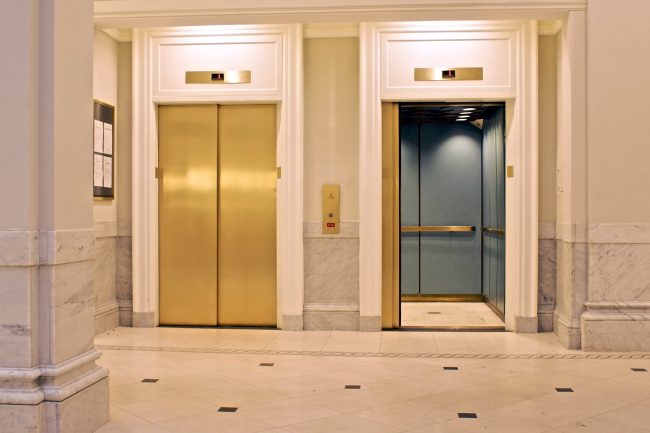
When you step into an elevator, you probably press a button without a second thought, trusting the metal box to deliver you safely. For the most part, that trust is justified. Elevators are statistically one of the safest forms of transportation; in fact, the fear of a cable snapping is mostly a movie trope.
However, that doesn’t mean they are perfect. The reality is that elevators have hidden safety flaws. These are not the dramatic, Hollywood-style failures. Instead, they are the subtle, common, and rarely discussed problems that cause the vast majority of injuries. Knowing them isn’t about creating fear; rather, it’s about being aware.
The Misalignment Problem: Tripping Hazards
The most common elevator-related injury has nothing to do with falling. Instead, tripping causes the most incidents. This happens when the elevator car does not stop perfectly level with the floor, a problem engineers call misalignment. Even a small difference of a half-inch can create a serious tripping hazard.
This is especially dangerous for elderly people or anyone with mobility issues. Worn-out brakes or faulty sensors often cause this issue. Ultimately, it’s a subtle flaw that can have painful consequences, so you should always watch your step when entering or exiting an elevator.
Door Malfunctions: More Common Than You Think
Elevator doors are a major source of problems. For instance, the sensors that detect an obstruction can fail, causing the doors to close on a person, a pet, or a personal belonging. While these doors are not typically powerful enough to cause serious crushing injuries, they can certainly cause bruising, falls, and panic.
Another issue is when the doors open when the elevator is not actually at the floor. An electrical or software glitch can cause this to happen. Consequently, it creates the terrifying risk of someone stepping into an open shaft. This is rare, but it is a known failure mode.
The “Emergency” Buttons That Don’t Connect
Imagine you get stuck in an elevator. You press the emergency call button, expecting a rescuer to connect with you immediately. But what if no one answers? In some buildings, especially older ones, maintenance staff don’t properly maintain these systems. Therefore, the call button may not connect to a 24/7 monitoring service.
Similarly, the “door open” button can be surprisingly ineffective. Technicians program many buttons to only work within a few seconds of the doors starting to close. Pressing it after that window may do nothing, which can then increase a person’s sense of panic and helplessness when trapped.
The Threat of Outdated Software and Maintenance
Modern elevators are complex machines that run on sophisticated software. That software needs regular updates, just like your computer. However, building owners may delay these updates due to cost. As a result, outdated software can have bugs and security vulnerabilities.
Poor maintenance is an even bigger issue. Elevators require regular, thorough inspections and preventative maintenance. When property managers cut corners to save money, however, small problems can become big failures. For example, they don’t replace worn-out parts and often skip safety checks. This is one of the most significant hidden safety flaws elevators have.
Why Power Outages Are a Real Risk
A power outage can leave an elevator stranded between floors. While most modern elevators have backup battery power, engineers usually only design it to get the car to the nearest floor and open the doors. They do not design it for continued operation. In older elevators, furthermore, this backup system may not exist or may fail.
Being trapped in a dark, enclosed space during a power outage is a frightening experience. Additionally, emergency lighting can fail, and ventilation can be poor. This situation is a leading cause of panic-related health emergencies in elevators.
Awareness, Not Fear, Is the Goal
Millions of elevator trips happen safely every single day. The point is not to make you afraid of them. Instead, the goal is to make you a more aware passenger. You should understand that elevators have hidden safety flaws that go beyond the dramatic fears we see in movies. Therefore, pay attention when you step in and out. If the elevator is making strange noises or seems to be operating erratically, trust your gut and wait for the next one.
Have you ever been stuck in an elevator? What was your experience like? Share it in the comments.
What to Read Next…
- 10 Safety Gadgets Women Refuse to Live Without—But Men Never Take Seriously
- 5 Safety Steps Women Should Know Before Using App‑Based Parking
- “Cybercrime Is America’s #1 Safety Concern—Here Are 6 Ways It’s Evolving”
- 7 Safety Tips You’ll Only Understand After Someone Tries to Break In
- 10 Common Mistakes Men Make That Put Their Safety at Risk

Latrice is a dedicated professional with a rich background in social work, complemented by an Associate Degree in the field. Her journey has been uniquely shaped by the rewarding experience of being a stay-at-home mom to her two children, aged 13 and 5. This role has not only been a testament to her commitment to family but has also provided her with invaluable life lessons and insights.
As a mother, Latrice has embraced the opportunity to educate her children on essential life skills, with a special focus on financial literacy, the nuances of life, and the importance of inner peace.







